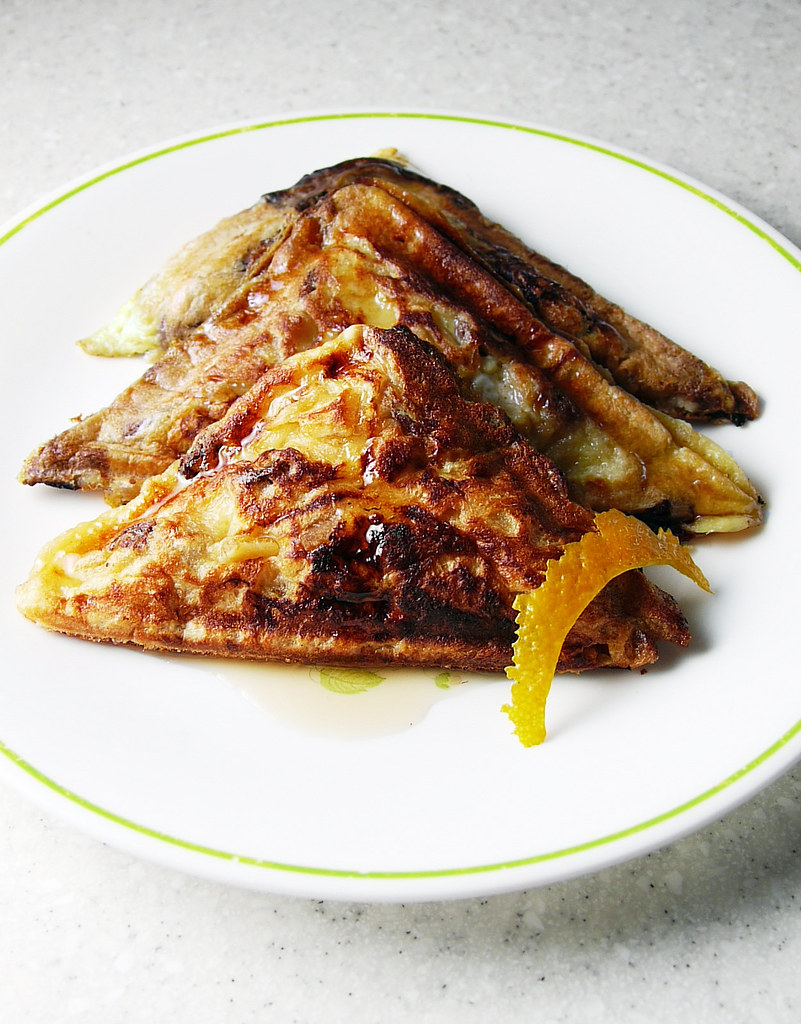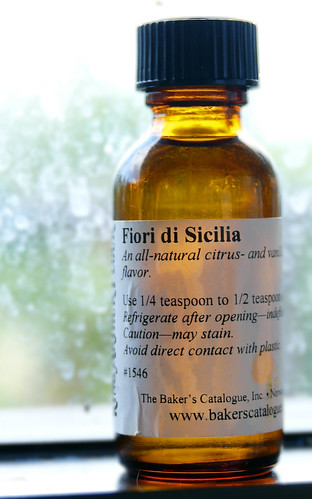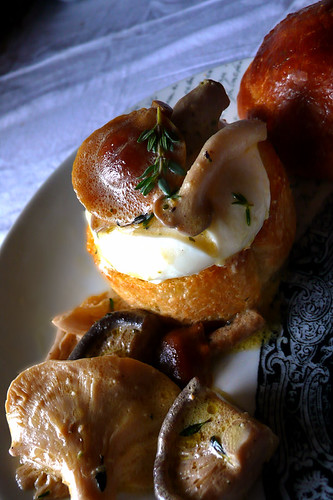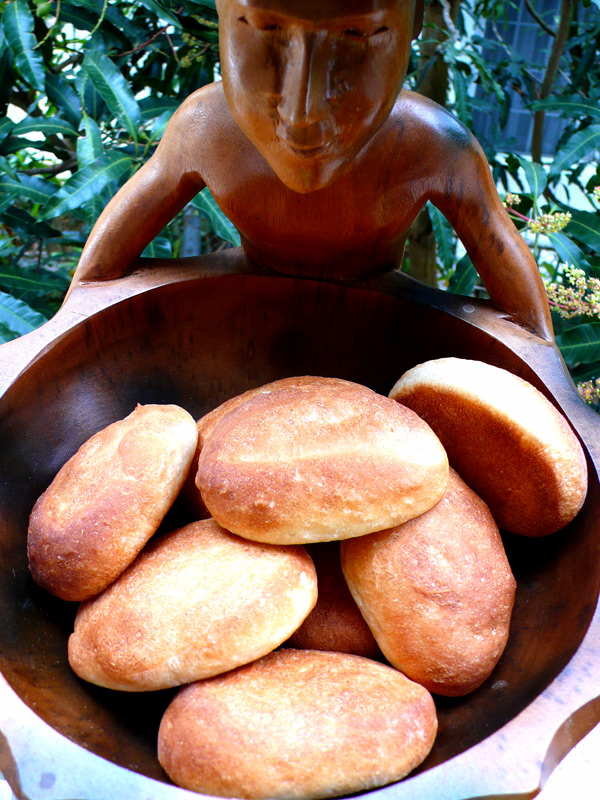20100115
| [+/-] |
toast of christmas past. |
20070614
| [+/-] |
brioche-ing the subject, pt.1. |
practice: it may not make perfect (yet), but darned if it doesn't make a better brioche than before. that, and a recipe that works for you. for me, it took three months, a dozen+ recipes, more dozens of unborn chickens and blocks o' butter later to find that this, this, this, and this recipe for the egg and butter-enriched dough equalled nope, nope, nope, and nope.
why the problem? i suspect a number of things: my stubborn desire to hand knead everything, not kneading enough, kneading too much, warm hands, warm and humid working conditions, butter that's pretty good, but with a water content that's probably not ideal for brioche. life getting in the way. you know. after spending a small fortune on ingredients, though, it inspires you to do better for your buck.
after a spectacularly failing performance with a gordon ramsay recipe and equally unspectacular jamie oliver one (i think it was an oliver. maybe.), i found a bit of goodness with a peter reinhart recipe from (yeah, you know it) "the bread baker's apprentice: mastering the art of extraordinary bread." it's that book with the asian woman on the cover? who's not actually the apprentice in question? that one. also, i acquiesced and broke out the stand mixer, and decided to only work on the dough in the cool of night. reinhard's recipe for "the rich man's brioche" didn't work for me no matter what the weather, maybe because of the high fat content. however, the "middle class" recipe with less butter and eggs did. it made a nicely crumbed, moist, buttery loaf that would have been fine sliced up on its own, but the reason why i wanted to work on brioche was because of all the tasty things one can do with it.
one of the first things i knew i had to try was umami's beautifully golden marmalade french toast, flavoured with vanilla bean and a healthy glug of orange-flavoured liqueur. very simple to make, albeit with an agonizing overnight refrigeration that makes it all the more tasty, and all the more tempting.
of course, the possibilities are endless. just like this post seems to be, so i'll end it here and continue shortly....
20070316
| [+/-] |
roll with it: from baguette to pandesal and back (eventually). |
it was maki who introduced me to that popular no-knead bread recipe; i enjoy a bit of mild pummeling, so it's not for me. it did get me thinking about bread making again, which i used to do on a fairly regular, fairly obsessive basis. i do bake bread occasionally, but have avoided the simplest, yet trickiest one for me: french-style baguettes. i could make very good ones, but the decade i spent away from regular bread baking has made me lose my touch. practice is all it really takes, but it really does take a lot of practice.
imho, the best dough for baguettes is the simplest: hard wheat flour, salt, yeast, water. obvs technique is the key. i still haven't perfected the richard bertinet kneading technique which calls for a wetter dough and a lighter touch, but i'm working on it. one of the things that bertinet recommends if you are a beginning bread baker is that one should try making little rolls or shapes instead of a whole loaf the first time. i was sceptical of this--i thought why not have one big failure instead of a dozen little ones?--but having done it, i concur with mr.b. the dough is easier to work and shape properly, the moisture in the bread dough is wicked away quicker in the smaller masses (which makes for a better crust and overall texture), and it takes less time to cook, for the anxious and excited amongst us.
*
around the same time i read maki's post, i read my cousin's post on a pandesal bakery in the manila 'burbs of marikina. supposedly they make "authentic" pandesal, which, as sassy says, could be the national bread of the philippines if the philippines had such a thing. the name literally translates to "bread of salt" (pan + de + sal), but almost every version i've had has been sweetish, not particularly salty, and frankly a little meh. neither here nor there--either too soft or too hard, too sweet or just bland. marketman lamented that true pandesal is difficult to find these days; the product of the 'fifties and 'sixties, according to marketman's sister, had a "hard crust, tender airy crumb and...It must have that distinctive crack down the middle." (i imagine that it probably tasted better too.) i found a photo of the pan de amerikana version, but it looks much like what can be found elsewhere. not as soft and spongy as commercial varieties have become, but my gut feeling is that it's not what the spanish or portuguese brought over back in the day. wiki saved the day with an excellent pandesal entry on the probable history complete with ingredients, which funnily enough are the basis for a good french baguette: hard wheat flour, water, yeast, salt. hm.
so, out came the pans and bowl. 500g of flour, 350g of water, 10ml of yeast, 10ml of salt. first, the yeast was dissolved in 100ml of water and left to bloom for 10 minutes. all ingredients then combined and kneaded to make a soft, elastic dough which should be allowed to double in a warm place. like guam, because it doesn't take an hour to do that. dough punched down, divided in half and formed into logs, which are cut with a sharp knife into equal pieces; each piece is placed cut side up on a baking sheet, and again, left to double.
a crispy crust that shatters is easy enough to get with a little steam during baking. the bread bakes in a 475˚F preheated oven--just slide the pans into the hot oven and use a spray gun filled with water to mist the sides of the oven and the tops of the bread with at least 10 squirts. close the oven door, leave for 5 minutes, then mist again. baked for another 15 minutes, the rolls should be golden brown, with a crunchy crust and tender, airy crumb.
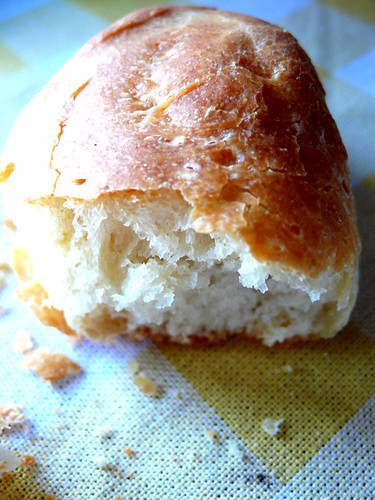
hey it works :)
i don't actually know if this is really like the pandesal of the past so here are some questions for you, if you don't mind. has anyone out there tried traditional pandesal? does this look similar? and is it actually, um, salty in taste?
and for the french bread eaters out there, what is it that you look for in a good baguette?
20070304
| [+/-] |
of bread and breakfast. |
there's nothing i can tell you about breakfast that an animated, all-singing, all-dancing, jaundiced loogy can't tell you better:
as mr. loogy says, you may not have the time for a well-balanced meal in the morning, but a little something is better than nothing. lately i've been craving breads and starches (i blame breadbar), so although these aren't the healthiest breakfasts, they are substantial, relatively economical in time and money to prepare, and oh-so-very tasty.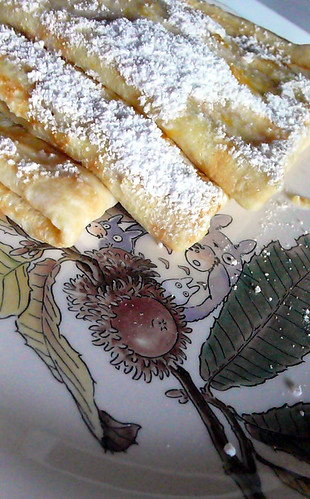
fat tuesday meant pancakes, so i had to have them. my favourite ones are more like the crepe variety than the flapjack/hotcake one; these were delia smith's basic pancakes with lemon and sugar. i substituted powdered sugar for the caster sugar as a topping, but otherwise a straightforward, simple recreation. the light sugar and fresh lemon liven up the tender 'cakes, which don't sit heavy in your tummy all day.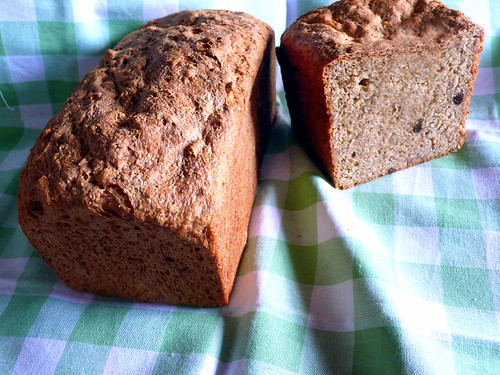
although this granola breakfast bread (eighth recipe/message) from marion cunningham's "the breakfast book" is a yeast bread, it surprisingly quick to prepare (although i did bake it the night before). the bread is like muesli in a loaf, made with whole wheat flour, corn meal, and granola. although the granola mostly blends into the dough, the nutty and fruity bits add texture and flavour, alongside the corn meal and whole wheat flour. (note: i did substitute graham flour for the whole wheat flour as that was all i hand on hand)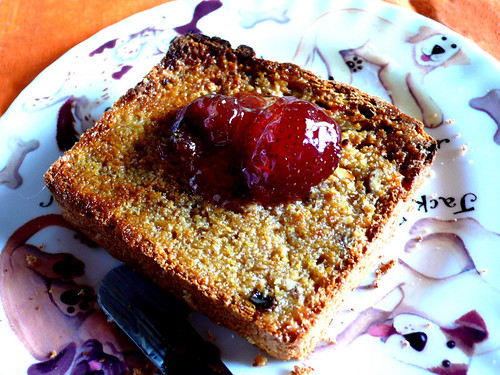
marion cunningham wrote that she had a slice of this toasted almost every day for breakfast, and i can see why. the crust is crunchy and crispy when made into toast; the innards are soft crumbed--almost like a muffin--cereal-scented, and eager to soak in lashings of butter and jam. i will definitely make these again, if only so i can fulfill a crazy desire to bake 52 loaves of bread this year, following mary jane's example...hopefully....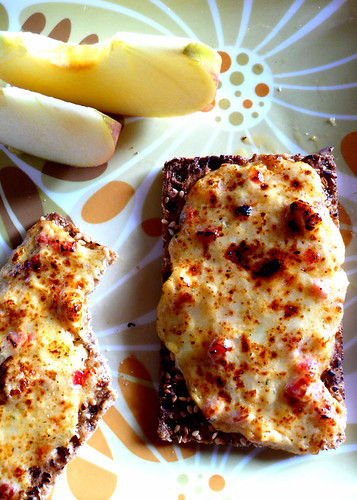
i don't keep the best stocked fridge (unless you count bath and beauty products), so sometimes creating a meal can be challenging. i had a few odds and ends of various cheeses, including some leftover queso de bola from the holidays, edam, gouda, cheddar and fontina; i took a page out of market manila and grated them all down, added a tiny bit of minced garlic, freshly ground pepper, diced pimientos, and a smidge of mayo to create a zesty cheese pimiento spread. a dollop of this was spread on rye crispbread and run under the broiler until browned and bubbly. sharp yet creamy, spicy yet mellow. crispy, tart apple wedges were the perfect foil for this. 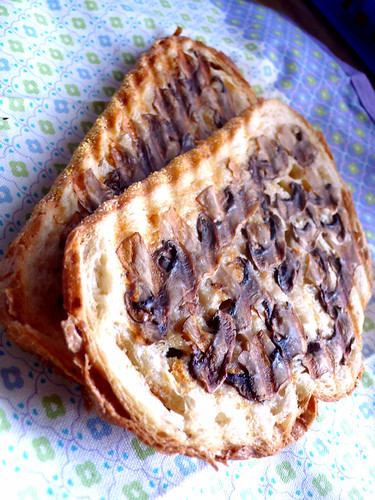
another meal that was borne from economy (and actually, "nancy silverton's sandwich book") has turned out to be a favourite--paper thin slices of white mushrooms arranged carefully on top of thin slices of sourdough wheat bread, drizzled with olive oil, and grilled in a panini press. sprinkled with sea salt and freshly ground pepper, this very simple open-faced sandwich is light in texture, but heavy in fungal flavour (snort). but you know, in a good way.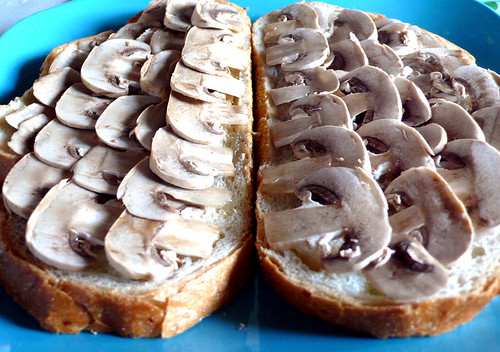
easy peasy, and a nice way to start your day. also, a good way to keep the creepy timer (yes, that's the "real" name of mr. loogy) from coming back to chide you o'er your food habits (although he has some other, helpful suggestions of which you might want to take note).
20061030
| [+/-] |
slather me in sugar and cinnamon, then let's just call it a day. |

remember that photo above? i've gotten quite a few requests for the recipe for those cinnamon rolls. although i have a preference for a more restrained product, sometimes you just gotta go with the gooiest, carbiest roll on the block, so i chose this recipe, which purports to be the clone of a popular chain brand's product. i wouldn't know about that, as i haven't had that particular roll in quite awhile. however, the recipe is quite good in a solid, no nonsense sort of way: lightly sweetened not-too-fluffy dough, with a nicely spiced innard and lots of sweet, creamy frosting on top. the only modification i did was to omit the vital wheat gluten, used a supermarket-brand yeast, and vietnamese cinnamon. also, i kneaded it by hand, and instead of putting five rolls per pan, just four for extra spready goodness.
 i also made a sticky buns version of it with lots and lots of chopped pecans, and a brown sugar honey sticky topping. i still used the dough from the cinnamon roll recipe, but added elise's cinnamon sticky buns topping (follow steps 4 and 5), only with roughly a third more pecans than specified. obvs the cream cheese frosting was omitted, but otherwise the recipe worked out quite well, and didn't seem overly sweet. well, you know. not for a sweet sugar sticky bun.
i also made a sticky buns version of it with lots and lots of chopped pecans, and a brown sugar honey sticky topping. i still used the dough from the cinnamon roll recipe, but added elise's cinnamon sticky buns topping (follow steps 4 and 5), only with roughly a third more pecans than specified. obvs the cream cheese frosting was omitted, but otherwise the recipe worked out quite well, and didn't seem overly sweet. well, you know. not for a sweet sugar sticky bun.i did intend to try and make a -cough- healthier version of this roll just for the heck of it. i bought what i thought was a ten-grain flour, along with some neufchâtel cheese, which is supposed less fatty than cream cheese (farmer's cheese is supposedly lighter as well). however, i inadvertently picked up this product, which is actually a bread mix and has yeast and other stuff thrown in. so, i followerd the directions on the label, added 1/4 cup of brown sugar, and 1 egg to the mix, and came up with a lovely, springy, multigrained sweet dough. for the filling i used the cinnamon roll recipe's filling, i used 1/2 cup brown sugar, 1 1/2 tablespoonfuls each of chinese, vietnamese, and ceylon cinnamon, and 1/2 cup of unsalted sweet butter. the mix of three cinnamons wasn't necessary, but it definitely added a more complex spicy taste--it was a little citrusy, a little peppery--that held up well against the grainier dough. that, along with the lighter creamy cheese frosting, made for a rather fine alternative for its more indulgent cousin.

a lighter creamy cheese frosting
4 oz. neufchâtel or farmer's cheese, softened
2 oz. unsalted sweet butter, softened
1 teaspoonful vanilla extract
1 squeeze of lemon juice, and/or 1 1/2 teaspoonfuls of lemon zest
1 cup powdered/confectioner's sugar, measured then sifted
beat the cheese and butter together until well incorporated. add the extract, juice, and zest. beat in the sugar until fluffy. slather on top of warm cinnamon rolls.
20060214
| [+/-] |
mr. & mrs. croque |
when one of my favourite hotels closed down, some of the things i considered buying in the liquidation sales were the pain de mie/pullman loaf pans from the kitchen. i just think they're cool looking. i ended up not buying any, and i've regretted it ever since, but i balk at paying the price for new ones. the other day, i went to the local restaurant supply shop, and found these cheapy cheap deep loaf pans that mimicked the pain de mie pans perfectly--all i would need to do is cover them with a cookie sheet during baking so i'd get the hallmark square shape of a pullman loaf. so that is what i did.
i found a recipe for pain de mie in the richard bertinet book, which included another recipe for what you can do with the bread: croque monsieur, which bertinet describes as a childhood staple in france, and is basically (but gloriously) a grilled ham and cheese sandwich. bertinet's version has thick slices of the pain de mie sandwiching a layer of béchamel, and slices of country ham; the top of the sandwich is then slathered with a thick layer of the béchamel, and a mountain of shredded gruyère cheese is layered on that. the whole sandwich is placed in a preheated 200˚C/392˚F (or thereabouts) oven until the cheese is melty golden brown.
i also tried out a recipe for croque madame i found in nancy silveron's sandwich book that i've wanted to try since i saw meg's version a zillion blogyears ago. this version is decidedly more refined, with thinner slices of bread, smoked ham, and slices of cheese instead of the lactose mountain; also, it is grilled rather than baked/broiled. why is it madame to the hearty, brutish monsieur? the egg, of course. sheeeeeeeeeeeesh.
a bit french, in that they were a little difficult to eat--runny sauce versus runny egg yolk, chunks of oversized squishy bread or grilled planks that exploded into a shower of crumbs with every bite. but both were a delightfully sensual experience-- warm, creamy, salty, buttery, cheesy...hammy. like brangelina, only with 30% less cheese. a happy pair together. that is, until i ate them.
20050317
| [+/-] |
ensaymada |

ensaymada, a filipino sweet bread, is one of the many pastries derived from spanish origins. ensaymada in fact are very much the same as their european counterpart, ensaimada, which are a pastry specialty of the balearic islands, most notably mallorca (majorca). although it is a spanish specialty, the origin of the ensaimada can theoretically be traced to the arabic occupation of the ibizan peninsula from 740 to 1235 AD and the explorations of the arab world by the spanish and portuguese. one belief is that the pastry may have been castilian, as the root of the name, saín, is the castilian medieval word for lard, from which the sweet breads are commonly made today. however, the arabic word for 'butter' was saim, which seems to be a better fit for the name, and for the pastry, which was known to be made originally with butter. it is thought that the mallorcan pastries only were made with lard when the catholic church encouraged the use of pork products to eradicate the arab indocrination of the region and to drive jews and arabs from the region altogether. controversial stuff, this.
however, by the time it got to the philippines, the recipe had reverted to its butter-based origins. the original sweet bread is one large snail-like coil dusted in sugar, but today individual sized cakes are more popular throughout the country. they are soft, buttery, milky and rich, and with the added slather of butter, sugar, and cheese, a sinful pillow of extravagance for your breakfast or tea.
ensaymada
3 1/2 to 4 teaspoonfuls of yeast
1/3 cup of lukewarm water
1 1/2 teaspoonfuls of white sugar
1/2 cup diluted evaporated milk or undiluted whole milk
1/2 cup white sugar
1/4 cup melted butter
3 egg yolks
2 1/2 to 3 cups unsifted all-purpose flour (after measuring sift flour)
grated mild white or yellow cheese, white sugar, softened butter for top or filling
dissolve the yeast in the lukewarm water and 1 1/2 teaspoonful of white sugar. mix, then set aside until bubbly. mix everything together until well incorporated and smooth. transfer dough into a greased bowl, let rise for one hour, then form into a log, flatten out and fill with cheese and butter (optional), or just coil into a snail shape in a greased pan. if you are making individual cakes, divide the dough in equal pieces, roll into logs and coil or knot and place in greased muffin tins. let rise for another hour, then brush with butter and bake in a preheated 300˚F oven for 25 minutes or until lightly brown. cool completely, slather with butter, dust with sugar and top with grated cheese, if desired. 
20050307
| [+/-] |
how the east was won, pt. 1 |

today is discovery day, the anniversary of ferdinand magellan's "discovery" of guam in 1521. of course, one should question how he could have discovered an island that was clearly already found and inhabited, but eh, anything for another holiday, right?
although magellan sailed under the spanish flag as a citizen of said country, he was actually portuguese. the portuguese explorers of the 15th through 18th centuries were a prolific and busy bunch, covering most of the pacific--vasco da gama landed in india, jorge alvarez in china, magellan in the marianas and the philippines, pedro fernandes de quieros in vanuatu, cristóvão de mendonca in australia, everyone in malacca....suffice it to say, the portuguese made their presence known.
i could probably make a case for the argument that the greatest contribution the portuguese made to asia was the introduction of potash, which is an important component for iron-making, and therefore the making of guns and firearms, but ugh, borrrring. however, potash in another form and completely different strength is a leavening agent, a form of baking powder. so, i rather weakly bring you the idea that the most important thing that the portuguese brought to asia is bread. not just any bread, but sweet bread, and sweet cake. in almost every major asian culture where the portuguese were found, sweet bread and sponge cake are staples in the cuisine. you will find these items in countries where wheat isn't even produced, where lactose intolerance is the norm, where the portuguese words for bread, pao and pan, are the same words in asian languages. now that's power, nenes.
*yawn*. blahblah. magellan was only on guam long enough to burn down a village, kill a few folks and steal a bunch of food, so there isn't actually any direct influence on the baked goods here. the major influence in the philippines was through spain, but i do believe that the sweet yeast breads that are common throughout the country actually originated with the portuguese explorers. pao doce/pan dulce, or, "sweet bread", is a mildly sweet, eggy and quite soft (unlike the more brioche-like spanish version) and is the base for many filipino confections.
for the next few days, i shall explore the lovely world of portuguese sweet breads in asia and the pacific, because it's my blog, fools. 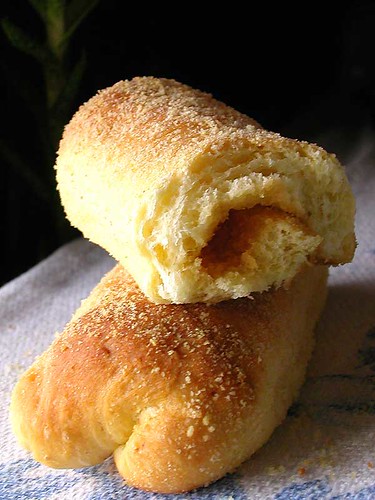
i'm also doing this because i'm convinced that there are so many traditional recipes that are endangered by homogenization and modern conveniences, they need to be not only written down but made available to anyone who wants "the real thing". while i don't claim that any of these recipes are authentic, they are as close to what i remember as the real deal. the first of these recipes is for something rather ironically called spanish rolls, which i am absolutely convinced is endangered, because i had difficulty obtaining each and every one of the six recipes i *did* find, and only one of them was a keeper (and that was tweaked endlessly). these are soft, tender, and slightly elastic rolls, pale yellow from egg yolks and butter, sweet from sweet butter and sugar incorporated in the dough, and from the sweet butter and sugar mix spread upon the dough. they are then formed, and rolled in breadcrumbs before baking. fresh out of the oven they are irresistible, and truly complemented by a café con leche or thick, rich hot chocolate.
spanish rolls
dough
1 to 1 1/2 packets of yeast
1/4 c warm water
1/2 c milk
1/2 c melted butter
1/3 c sugar
4 egg yolks
1 tsp salt
3-3 1/2 c all purpose flour
filling (optional)
3/4 c breadcrumbs
1/2 c brown sugar
1 tbsp all-purpose flour
1/2 tsp baking powder
1 tsp vanilla extract
extra breadcrumbs
dissolve yeast in warm water. in a bowl, combine milk, butter, sugar, egg yolks and salt. blend well then add the yeast mixture and enough flour to make a moderately stiff dough. transfer dough to a floured surface and knead until smooth and elastic. place dough in a greased bowl, cover and let rise until double in bulk.
punch down dough then divide into equal pieces. combine all the ingredients for the filling. roll out each dough into a small rectangle. brush with butter then spread with some of the filling (or you can just sprinkle a little sugar on the butter or omit this step). roll up, then cover in breadcrumbs. place seam side down on greased baking sheets. let rise until doubled in bulk again then bake in a preheated 325˚F oven for 20 minutes or until lightly brown. 
similar, but not the same: kt from blue and yellow kitchen's cheese rolls. sweet and savoury, and thoroughly addictive.
20050209
| [+/-] |
spring onion bread |
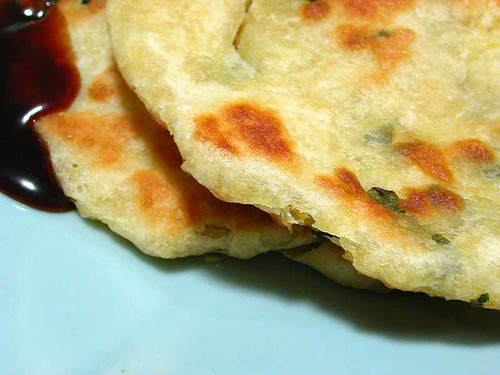
i am too full to blog. recipe here. chinese in origin, but awesomely tasty with indian-spiced food or on their own.
20050129
| [+/-] |
adobo buns |

there are a lot of recipes for adobo out there :-)
i was having a craving for manapua, a sort of baked meat-filled bun. did a little improvising, searched the fridge, came up with this pork and chicken adobo bun. i shredded the chicken, chopped up the pork, added a little of the gravy (cold, for easier handling). made a dough that was sort of a cross between soft, sweet manapua dough and pandesal by taking my basic bread recipe (1 packet yeast, 3 cups flour, 1-1 1/2 c. water, a little sugar, a little salt, a little oil) and adding a tablespoonful of honey, two eggs, and substituting a half-cup of the water with melted butter. sounds funky, but it worked, as it wasn't too dairy tasting, and the bread was firm enough to hold in the saucy filling. wrapped a couple heaping tablespoonfuls of the meat and gravy in the dough, pinched it closed, put the "dimpled" side down, brushed the tops with an egg wash, and after rising, baked in a 350 oven for 20-25 minutes. perfect on-the-go parcels, if you can resist eating them fresh out of the oven.
20041203
| [+/-] |
dairy bread |

i'm back to baking. never mind the batch of meringues i forgot in the oven before i left (shhhhhhh! bleah.) i brought back a favourite cookbook from my la collection, "the breakfast book" by marion cunningham, mainly because chika reminded me of its existence, and after flicking through it again, i realised there were quite a few recipes i was curious about. not necessarily about the taste, but from some quirky aspect or ingredient in them.
one of these recipes is a yeast bread recipe simply called dairy bread. it is basically a white bread loaf, only loaded with dairy products, including cottage cheese. the thing that piqued my interest was the addition of a scant 1/4 teaspoonful of ground ginger, which was believed to help the yeast work more effectively. hm. i can't say if it did or not--i suspect the teaspoon of sugar added to the proofing yeast had more efficacy. however, because the bread is so bland (it really tastes like baked milk--depending on your fondness for dairy products, this could be a good or bad thing), i found that tiny bit of ginger lent a peculiar bite to the crust. again, don't know if this is a good or bad thing. otherwise, the crumb was soft but springy and it makes a lovely toast.
i did have a little trouble with the directions--it says to add only enough flour to make it manageable, but later it says to knead it until it is smooth and elastic. to make it smooth and elastic, i had to add considerably more flour than it took to make it manageable (a whopping 2 cups more), but even with those two extra cups, the loaves were a little flooby. it was perhaps a mistake to read a novel with a character who laments the loss of her teenage cleavage while i was making these loaves. you only need to look at the final product to see why the only thing that came to mind was "support bra".
dairy bread (from "the breakfast book" by marion cunningham, pg. 7)
1/2 cup warm water
2 packets dry yeast
1/4 tsp ground ginger
1 tsp plus 2 tbsp sugar
1 1/2 cup milk, warmed
1 cup cottage cheese
2 tbsp butter, room temperature
1 1/2 tsp salt
6 cups all-purpose flour, approximately
put the wam water, yeast, ginger and 1 tsp sugar in a large mixing bowl. stir and let the mixture dissolve for 5 minutes. add the milk, cottage cheese, butter, the remaining 2 tbsp sugar, salt and 3 cups flour. beat until smooth. add only enough additional flour to make the dough manageable. turn the dough out onto a floured surface and knead for 2 mminutes. let the dough rest for 10 minutes, resume kneading until smooth and elastic.
place the dough in a greased bowl and cover with cling film. let the dough double in bulk, about 1 hour. punch down and divide in half. form two round loaves or place in two loaf pans, cover loosely and let rise for 45 minutes to an hour. sprinkle a little flour on top and cut a cross on the top of each loaf. place in an oven preheated to 375˚F, and bake for 40 to 50 minutes, or until the bread is golden on top.
20040914
| [+/-] |
recipe: pain perdu. |

pain perdu with warm guava preserves and mascarpone
part two in the dead bread trilogy
pain perdu, literally "forgotten bread" in french, aka french toast. i like the idea of forgotten bread, the phrase "french toast" makes me think of clinking champagne glasses at new year's. i like to bake pain perdu instead of pan frying it, as it uses less butter, and frankly, i'm totally useless first thing in the morning--it's an effort to turn a knob, never mind flipping things in hot fat.
ingredients: 8 slices of stale bread, 4 eggs, 2 cups milk, pinch of salt. since i usually use bone dry bread (see part 1 of the dbt), this dish must be refrigerated overnight, or left to sit for at least half an hour. because of the varying soaking times, you'll get different results--the bread that is left to soak overnight is softer and slightly custardy, the half hour soaked bread is firm and has a bit of tooth.
if you are going for the overnight method, grease or butter an ovenproof dish, place the bread in the dish (try not to overlap the slices). mix the remaining ingredients, pour on top of the bread, and refrigerate overnight.
the half hour method is similar. place the bread in a shallow dish, and pour the other mixed ingredients on top. soak for 30 minutes (less if the bread is thin, more if it's not). take the bread out of the egg mixture, and place on a greased baking sheet or dish.
for both methods, bake for 40 minutes at 350˚F. you may need to turn the bread over once for the bread that hasn't sat overnight in the fridge.
why have two methods? well, you never know how much time you'll have. also, you may be looking for a particular texture for the dish. when i am making a sweet pain perdu, i like to use the overnight method, and sometimes i'll add orange zest, vanilla, or a few tablespoons of sugar to the egg mixture. for a savoury dish, i will slit the bread in half and stuff it with ham and/or cheese, and when it's soaked for a short period of time, it becomes similar to a monte cristo sandwich, only marginally healthier, as it's not deep fried in butter. i will also toss some chopped vegetables coated in olive oil (zucchini works well) in, to mini-roast along with the stuffed bread.

pain perdu stuffed with ham and brie, served with roasted cherry tomatoes
20040913
| [+/-] |
recipe: panzanella. |

part one of the dead bread trilogy
i cannot finish a loaf of bread. my freezer is an icy graveyard of half-consumed loaves of wholegrain, pan de mie, pullman, and rye, diminished batards and baguettes that look like toppled gravestones and markers. there is only so much one can do with breadcrumbs, so i have a passel of recipes i file under "dead bread".
one of my favourites is a tuscan bread salad known as panzanella. it is extremely simple to make, but completely dependent on the freshness of your ingredients for it to be successful. perversely, the bread you use for this has to be as stale as possibly without being rancid or moldy--bone dry is best.
this particular recipe is based on my favourite version of panzanella, from the quietly fantastic angeli caffé in los angeles. it is the first version i'd ever tried, and i have not been able to find another that is comparable to it in freshness, simplicity, and flavour.

cut up at least two large ripe, but firm beefsteak-type tomatoes--you will want to use the juiciest and sweetest tomatoes possible(romas aren't juicy enough and cherries are too acidic)--in a rough dice. glug a generous amount of high quality extra virgin olive oil (about 1/2 cup) and a scant 1/4 cup red wine vinegar on top. add a fistful of rinsed, drained capers and leave to marinate. roughly chop 3 cups of stale bread (ciabattas or baguettes work well--anything with a lot of crust), into 1-1 1/2 inch cubes. peel a common slicing cucumber, cut in half and de-seed it by running a spoon through the middle. cut into bite-sized crescents. de-seed a large green bell pepper, cut into strips. mix the bread in with the vegetables in a large bowl, dump the tomatoes and the all the marinade on top. season generously with salt and pepper. the marinade soaks through the bread, just enough to give it chewiness. the bread and the cucumbers foil the acidity of the tomatoes and vinaigrette, and the bell peppers add a nice greeny touch.
20040831
| [+/-] |
cheesy carby things |

tomato basil (what's that? ok, whatever) cheesy bread
the teenage relations are addicted to pizza, but their folks are (understandably) loathe to constantly part with the dosh for the pie to sate their seemingly endless appetites. these growing (fortunately more up than out) kids range from 11 to 17, and their ability to hoover down the goods is mind-boggling.
so, one afternoon, i taught them a simple, relatively fast and fumbleproof bread recipe so they could make their own pizza-like creations. since the emphasis was more on cheap than authentic, we made focaccia-like pan breads which they could top with whatever was in fridge.
the basic dough recipe is 3 cups flour, 1 cup water, 1 packet of yeast, 1 tsp. of salt, 1 tsp. of sugar, 1 glug of olive oil. mix and knead until smooth, throw into a large storage bag or container and leave to rise for 1 hour at room temperature or overnight (or, during school) in the refrigerator. oil a baking pan, smoosh dough gently with fingertips to fit the pan, leave for at least a half hour, ideally an hour (do some homework already!), top with stuff, bung into an oven heated to 400ºF, for 20-25 minutes, depending on the shape of the pan. easy enough for kids to remember, filling enough for their guts, and cheap enough for them to be left with more money for (sigh) more ps2 games.

ham and cheesy bread

